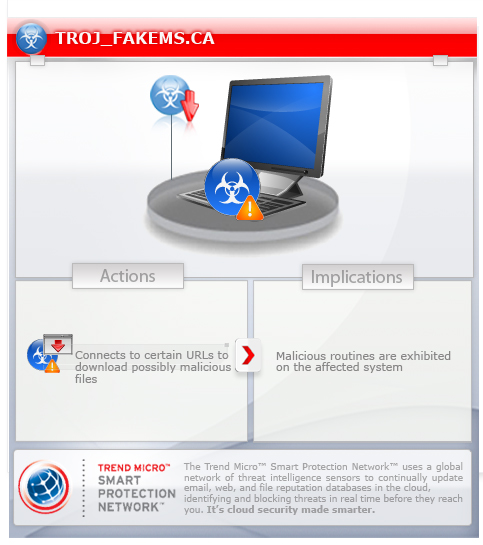TROJ_FAKEMS.CA
Windows 2000, Windows Server 2003, Windows XP (32-bit, 64-bit), Windows Vista (32-bit, 64-bit), Windows 7 (32-bit, 64-bit)


Threat Type: Trojan
Destructiveness: No
Encrypted: No
In the wild: Yes
OVERVIEW
Dropped by other malware
This malware is involved with a spam attack during January 2013. It arrives as a dropped file from a spammed mail with the body written in the Japanese language and bearing the subject New Year Greetings. It appends garbage code to the copy it drops in order to avoid detection.
To get a one-glance comprehensive view of the behavior of this Trojan, refer to the Threat Diagram shown below.

This Trojan may be dropped by other malware.
It executes the downloaded files. As a result, malicious routines of the downloaded files are exhibited on the affected system. As of this writing, the said sites are inaccessible.
It deletes the initially executed copy of itself.
TECHNICAL DETAILS
55,219,364 bytes
EXE
Yes
10 Jan 2013
Drops files, Downloads files
Arrival Details
This Trojan may be dropped by the following malware:
- TROJ_DROPPER.AJM
Installation
This Trojan drops the following copies of itself into the affected system and executes them:
- %Program Files%\Windows NT\Accessories\Microsoft\mslives.exe
(Note: %Program Files% is the default Program Files folder, usually C:\Program Files in Windows 2000, Server 2003, and XP (32-bit), Vista (32-bit), and 7 (32-bit), or C:\Program Files (x86) in Windows XP (64-bit), Vista (64-bit), and 7 (64-bit).)
Autostart Technique
This Trojan adds the following registry entries to enable its automatic execution at every system startup:
HKLM\SOFTWARE\Microsoft\
Windows\CurrentVersion\Run
msliveupdate = "%Program Files%\Windows NT\Accessories\Microsoft\mslives.exe"
Download Routine
This Trojan connects to the following website(s) to download and execute a malicious file:
- http://www.{BLOCKED}a-group.co.jp/news/topics.html
It saves the files it downloads using the following names:
- %User Temp%\mscxml.exe
(Note: %User Temp% is the current user's Temp folder, which is usually C:\Documents and Settings\{user name}\Local Settings\Temp on Windows 2000, XP, and Server 2003, or C:\Users\{user name}\AppData\Local\Temp on Windows Vista and 7.)
It then executes the downloaded files. As a result, malicious routines of the downloaded files are exhibited on the affected system.
As of this writing, the said sites are inaccessible.
Other Details
This Trojan deletes the initially executed copy of itself
NOTES:
This Trojan checks if the full path of the current running process is %Program Files%\Windows NT\Accessories\Microsoft\mslives.exe. If so, it will download a file. But if the full path is different, it will drop a copy of itself, %Program Files%\Windows NT\Accessories\Microsoft\mslives.exe, and execute it afterwards.
Also, it drops copies of itself in various file size, appending garbage codes, to avoid easy detection.
SOLUTION
9.300
9.648.06
10 Jan 2013
9.649.00
11 Jan 2013
Step 1
Before doing any scans, Windows XP, Windows Vista, and Windows 7 users must disable System Restore to allow full scanning of their computers.
Step 3
Restart in Safe Mode
Step 4
Delete this registry value
Important: Editing the Windows Registry incorrectly can lead to irreversible system malfunction. Please do this step only if you know how or you can ask assistance from your system administrator. Else, check this Microsoft article first before modifying your computer's registry.
- In HKEY_LOCAL_MACHINE\SOFTWARE\Microsoft\Windows\CurrentVersion\Run
- msliveupdate = "%Program Files%\Windows NT\Accessories\Microsoft\mslives.exe"
- msliveupdate = "%Program Files%\Windows NT\Accessories\Microsoft\mslives.exe"
Step 5
Search and delete this file
There may be some component files that are hidden. Please make sure you check the Search Hidden Files and Folders checkbox in the More advanced options option to include all hidden files and folders in the search result.
- %User Temp%\mscxml.exe
Step 6
Restart in normal mode and scan your computer with your Trend Micro product for files detected as TROJ_FAKEMS.CA. If the detected files have already been cleaned, deleted, or quarantined by your Trend Micro product, no further step is required. You may opt to simply delete the quarantined files. Please check this Knowledge Base page for more information.
Did this description help? Tell us how we did.

